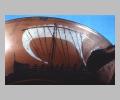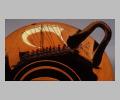
Side B: war ship

Side B: merchant ship

Side A: oblique from below

Side B: merchant and war ships

Interior: view from above

Side A: warship
| Collection: | London, British Museum |
| Summary: | Side A: Merchant vessel and war ship sailing towards each other. Side B: Similar to Side A. Int.: Gorgoneion. |
| Ware: | Attic Black Figure |
| Context: | From Vulci |
| Date: | ca. 540 BC - ca. 500 BC |
| Dimensions: | H. 0.084 m., D. 0.276 m. |
| Shape: | Kylix |
| Beazley Number: | 479 |
| Region: | Etruria |
| Period: | Archaic |
Decoration Description:
Side A: A merchant vessel is facing right, approached by a war ship. The merchant vessel is rigged with a mast and sail, and it has an apotropaic eye painted on its bow. At the stern is a landing-ladder, and a steersman with the steering oars. Along the sides are lattice-work bulwarks. The sails are furled. Sailing towards it is a war ship with mast and sail. Its prow is in the form of a boar's head, and it has a high fore-deck, steering oars and a landing ladder at the stern. The bulwarks are the same as the merchant ship's. Eight figures can be seen rowing the upper set of oars (there are at least as many people on the lower deck) and the sail is fully extended, giving the impression that the boat is moving "full steam ahead."
Side B: A similar design as Side A. The merchant vessel has unfurled sails in this scene, while the people in the war ship are standing up; one is holding onto the end of a sail, and the other two are hauling on ropes. The war ship is towing a smaller boat, to the right, which has an apotropaic eye painted on the prow. The surface of the sea is indicated with a wavy line.
Interior: A Gorgoneion is depicted, with curly hair, a protruding tongue, and tusks.
This was originally interpreted as a boat race scene (Harrison, 29), but it is more likely that it depicts a pirate ship overtaking a merchant vessel. Side A is the first part of the story, where the pirate ship races toward the unsuspecting boat, using all of its oarsmen and sails. On Side B, it has reached its prey; the pirates have leapt up from their oars and are pulling down the sails as they prepare to board the merchant vessel. The latter, realizing too late what is happening, is attempting to escape under sail (Casson 1971, 128).
Collection History:
From the Blacas Collection
Sources Used:
JHS VI (1885) 29
Other Bibliography:
Antike Seefahrt (Munich 1985) 55, fig. 43JdI VII (1892) 53Greece and Rome XVIII (1949) 144, pl. LXXXVIII, 4cJHS LXXVIII (1958) 14-16, pl. V, VIJHS LXXVIII (1958) 127, pl. XIVe